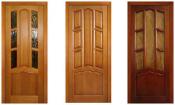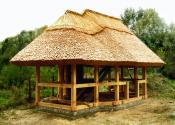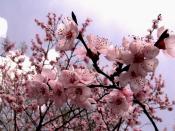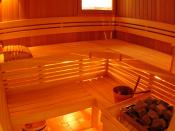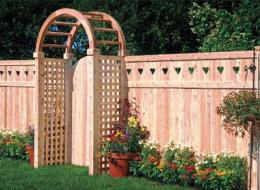Search
Login
Recommended
Options for decorative fences in the garden
Contrary to popular belief, not only a well-groomed garden, flower beds with exquisite plants or all kinds of decorative elements can become an adornment of a personal garden, but also a fence, which can be the embodiment of a whole art. That is why every owner of the house area seeks to diversify it in accordance with their aesthetic preferences and material capabilities, because instead of the usual boring fence made of concrete slabs, mesh netting or slate, you can, with a little imagination, build a decorative fence from a variety of materials, of which the construction market is a great many.
Content
- Functions of decorative fences. Plastic decorative fence video
- Decorative fences made of wood. Basic options and style video
- Metal decorative fence. Manufacturing technique and necessary materials
- A variety of concrete fences. Forms for decorative fences
- Fences for flower garden fencing
Functions of decorative fences. Plastic decorative fence
However, decorative fences are necessary not only for the fencing of the local area. Zoning the site, delimiting the recreation area on which the grill and hammock are located, and the garden, arranging the necessary accents and decorating the flower beds and protecting them from pets, all this requires the creation of a decorative fence with your own hands or the purchase of a finished product.


How to make a decorative fence and what materials are preferable to use? We will talk about this and how to install a decorative fence on a personal plot without violating its general style, in our article.
An ideal option for decorating flower beds and protecting them from careless guests would be a plastic decorative fence.

The construction market offers a wide range of similar products, since the technical characteristics of the material used determine the high demand for these products. Thermoplasticity of plastic allows you to set the fence as a border for garden paths or a protective fence for plantings, front gardens of the most bizarre shape, and the new-fashioned method of lamination allows you not to limit yourself in color schemes.


To mark the boundaries of garden paths or to establish a decorative element for flora compositions, you can use the sectional type fence, each section of which is equipped with pegs, which will greatly facilitate the installation process. The ability to simulate wooden picket fence, wattle, masonry or forged elements is another important advantage of plastic fences.

Decorative fences made of wood. Basic options and style
One of the most popular types of fencing are decorative wooden fences, which represent an extensive group of various options.


As for the types of wooden fences, experts in this area distinguish the following groups:


1. A wooden fence, the main material for which is a board. Contrary to established beliefs, such a fence can be used not only to delimit the economic territory and buildings, but also, provided that it is made from edged boards with firing and high-quality finish, it can become a spectacular decorative element.
2.Wood picket.

At first glance, the simplest fence, but if you vary the frequency of the packing, the shape and finish of an individual element and the distance between them, a primitive fence can be turned into a real work of art.

3. A decorative wattle fence, which is in perfect harmony with the natural landscape.

Making it is quite simple, without much time. To erect such a fence, you will need willow, apple or birch rods with a thickness of not more than 2 cm, the number and length of which depends on the expected size of your future wattle fence.

To erect supports for wattle, it is necessary to stock up with thick birch stakes, the height of which also depends on the height of the structure and your preferences. For owners who decide to make wattle on the personal plot with their own hands, we also recommend stocking up with wood screws and metal wire.

When planning to install a decorative fence made of wood, owners of the local area first of all think about the operational life of wooden fences and the cost of the issue. The latter mainly depends on the quality of the material and its processing, and can be both low and unbearably high. For example, a decorative wooden fence made of industrial varieties of wood and complemented by carvings and easy firing can be a quite acceptable purchase, unlike an oak fence decorated with artistic carvings and a decorative gate, which is far from everything for every wallet.

As for the preservation of the overall style of the site, the wooden fences are suitable for decorating sites made in various stylistic directions.

Given the facade of the building and the style of the local area, a decorative wicker fence will be the perfect complement to a country-style plot and a wooden house.


Moreover, the wicker design, decorated with old dishes and clay pots, will be a spectacular addition to the plot with an apple orchard and an artificial decorative well.

Metal decorative fence. Manufacturing technique and necessary materials
If your garden is made in the Japanese style, then you can not do without installing a decorative metal fence,

which has a long service life (subject to annual painting) and a rather spectacular appearance.


Such a fence can be purchased by ordering it according to an individual sketch, or made independently. To create one section of such a fence (its dimensions 90 x 55 cm) you will need:

1. For supports and crossbeams 4 metal fittings with a diameter of 12 mm and a length of 90 cm;
2. For horizontally located crossbars 2 metal rods with a diameter of 10 mm and a length of 39 cm:
3. And metal decorative elements for the fence, for example, art forging elements.

The crossbeam is welded at a distance of 50 cm from the top of the support rods, the second beam at a distance of 40 cm from the first crossbeam. Horizontal bars are mounted at a distance of 15 cm from each other. Welding of decorative elements is carried out staggered, and the installation of the fence is carried out by pressing the supporting rods into the ground.

A variety of concrete fences. Forms for decorative fences
One of the most popular types of fences is the decorative fences of their concrete, which are famous for their durability, comparable to a fairly low cost.

It is generally accepted that a concrete fence is a gray and monotonous fence that is depressing, but this idea has long ceased to be relevant. Today, the production of concrete fences is carried out using forms for decorative fences, which are made of fiberglass, which allows you to create fences of a wide variety of designs, simulating masonry, natural stone and many other design decisions.

Moreover, concrete fences can be either one-sided (the picture is viewed only from the outside), or two-sided, characterized by the drawing on both sides.

It is worth noting that the market offers a wide variety of concrete products that can be used for decorative design and zoning of the site.

First of all, it is a variety of borders that can be used for decorating garden paths, fencing lawns and decorating flower gardens on the garden plot.

Innovative technologies, characterized by accelerated development, allow us to produce similar products of a wide variety of colors and textures. It is worth noting that using plastic or polyurethane molds for decorative fences, which were mentioned earlier, such a fence can be made independently.

Fences for flower garden fencing
As mentioned above, fences can be used not only to fence the site, but also for zoning the territory and arranging the necessary accents.

For this purpose, fences can be used to design flower beds, which can be made of cobblestones of the most diverse shapes, which are selected in such a way that the style of the fence can resemble a medieval one. In this case, stones with a rough texture will successfully contrast with the tender greenery of the vegetation.

